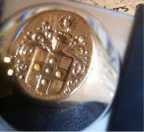There is a powerful and beautiful exhibit at The Pulitzer Arts Foundation. It is titled:
Since Mike Brown was killed on August 9, 2014 I have read numerous books on racism, the school to prison pipeline, sundown towns and the great migration. I have read histories of race relations in St. Louis, numerous articles, newspaper stories and I've spent a fair amount of time on the street. Among the many things I've learned is that the history we present in schools, mainstream media, and in art institutions is not commensurate with all too many of the facts of the lived experience of many, if not most of my fellow Americans who happen to be black. Their story need not be told by me; plenty of black folks do a fine job of putting the information on the table for all of us to read. I've shared reading lists elsewhere. Left Bank Books has a good one.
Still, my heightened interest in the inadequacy of our representations of history, vis-à-vis race, was piqued by the Kota exhibit at Pulitzer Arts. Seven weeks ago I posted an image on IG from the exhibit with the following comment:
rrconstructorstunningly beautiful Kota figures @pulitzerarts in the #stl - how did they get out of Africa? when will the be returned? discuss....appropriation or misappropriation?
I have an opinion about the matter, but I simply don't 'know' enough to voice it as more than an invitation to discussion. To that end I was grateful for the event Pulitzer Arts hosted called The Ethics of Study, The Pulitzer's curator and an art historian from SLAM presented/lead a discussion that did not bring up the issues from my IG post, but the issue was not ignored during our questions and discussions either. The Pulitzer's Director of Public Projects shared that they added more explanatory material to the exhibition hand outs while acknowledging that a different range or scope of thought about origins, etc. might have been of value from the onset. I respect and appreciate this.
However, I remain bothered that a big chunk of reality is given short-shrift in the 21st Century. Howard Zinn's work and that of others is no longer hard to find. We know there is another side to the coin and, especially after the Ferguson Uprising, it seems to make no sense to ignore all that is known if a person or an institution wants to maintain credibility. This article: Central Africa: Price of Kota Sold in Paris Is Interesting...is worth a read for another perspective on the 'Kota market' and the problematic issues of provenance.
The rest of what I have to share plays out in images more than anything else. How might we come to feel/have a clue about the experiences of our brothers and sisters of color? For me it is about watching and listening and concentrating on understanding, rather than responding. I assume there will be times when I get it wrong. I speak now only of the emotions and ideas that occurred to me.
Browsing through Phaidon's monograph,
Theaster Gates I came across this image from a glass slide he rescued from deaccession by the University of Chicago.
It is referred to as a 'wooden idol.' The times, I suppose have changed. I posted this on Twitter and Gates (w/ whom I worked on a Rebuild Foundation project in St. Louis) re-tweeted it. It seemed to tie western views of African history from the past to the present. Only the names have changed.
I have enjoyed the work of Glenn Ligon for a long time. His use of stencils is something I've always liked. Here is one of my favorites.
These are quotes from Zora Neal Hurstan's essay How It Feels to Be Colored Me. The essay was published in 1928, perhaps near the time of the glass slide above was made. I first read about her in Rampersad's biography of Langston Hughes. She was a pivotal and inspirational figure of the Harlem Renaissance.
Glenn Ligon's presentation of Ms. Hurston's words popped into my head as I looked at the photograph I took of the Kota at the Pulitzer.
We owe it to everyone to produce and demand accounts and presentations of art and art history that includes an accurate and holistic presentation of what we know. Let's keep the conversation going and the pressure on.










